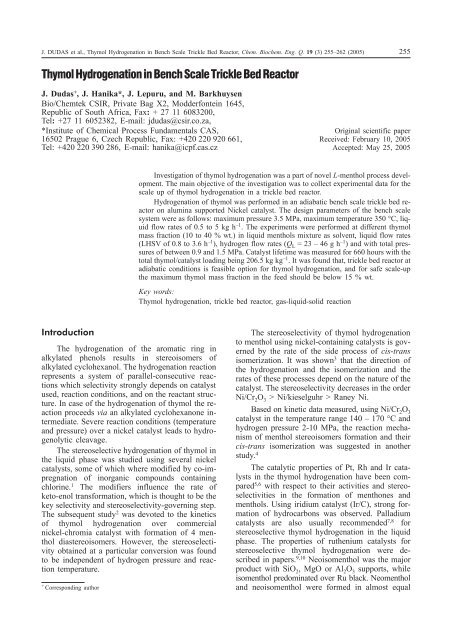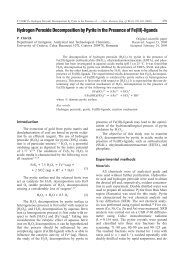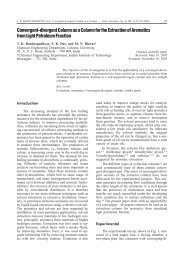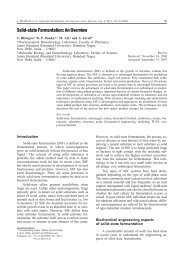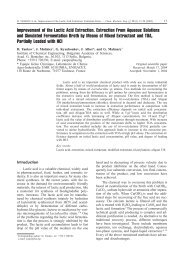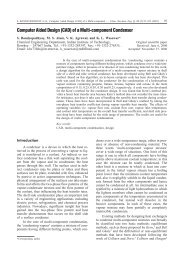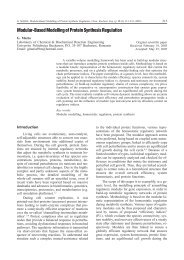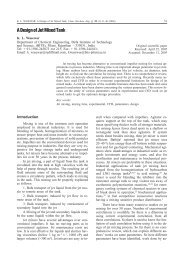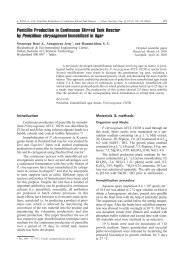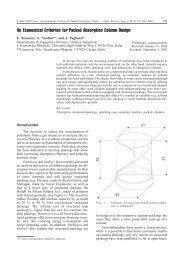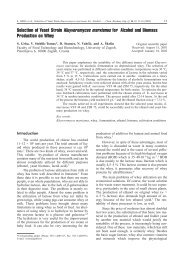Thymol Hydrogenation in Bench Scale Trickle Bed reactor - pierre
Thymol Hydrogenation in Bench Scale Trickle Bed reactor - pierre
Thymol Hydrogenation in Bench Scale Trickle Bed reactor - pierre
Create successful ePaper yourself
Turn your PDF publications into a flip-book with our unique Google optimized e-Paper software.
J. DUDAS et al., <strong>Thymol</strong> <strong>Hydrogenation</strong> <strong>in</strong> <strong>Bench</strong> <strong>Scale</strong> <strong>Trickle</strong> <strong>Bed</strong> Reactor, Chem. Biochem. Eng. Q. 19 (3) 255–262 (2005) 255<br />
<strong>Thymol</strong><strong>Hydrogenation</strong><strong>in</strong><strong>Bench</strong><strong>Scale</strong><strong>Trickle</strong><strong>Bed</strong>Reactor<br />
J. Dudas + , J. Hanika*, J. Lepuru, and M. Barkhuysen<br />
Bio/Chemtek CSIR, Private Bag X2, Modderfonte<strong>in</strong> 1645,<br />
Republic of South Africa, Fax: + 27 11 6083200,<br />
Tel: +27 11 6052382, E-mail: jdudas@csir.co.za,<br />
*Institute of Chemical Process Fundamentals CAS,<br />
16502 Prague 6, Czech Republic, Fax: +420 220 920 661,<br />
Tel: +420 220 390 286, E-mail: hanika@icpf.cas.cz<br />
Orig<strong>in</strong>al scientific paper<br />
Received: February 10, 2005<br />
Accepted: May 25, 2005<br />
Investigation of thymol hydrogenation was a part of novel L-menthol process development.<br />
The ma<strong>in</strong> objective of the <strong>in</strong>vestigation was to collect experimental data for the<br />
scale up of thymol hydrogenation <strong>in</strong> a trickle bed <strong>reactor</strong>.<br />
<strong>Hydrogenation</strong> of thymol was performed <strong>in</strong> an adiabatic bench scale trickle bed <strong>reactor</strong><br />
on alum<strong>in</strong>a supported Nickel catalyst. The design parameters of the bench scale<br />
system were as follows: maximum pressure 3.5 MPa, maximum temperature 350 °C, liquid<br />
flow rates of 0.5 to 5 kg h –1 . The experiments were performed at different thymol<br />
mass fraction (10 to 40 % wt.) <strong>in</strong> liquid menthols mixture as solvent, liquid flow rates<br />
(LHSV of 0.8 to 3.6 h –1 ), hydrogen flow rates (Q L =23–46gh –1 ) and with total pressures<br />
of between 0.9 and 1.5 MPa. Catalyst lifetime was measured for 660 hours with the<br />
total thymol/catalyst load<strong>in</strong>g be<strong>in</strong>g 206.5 kg kg –1 . It was found that, trickle bed <strong>reactor</strong> at<br />
adiabatic conditions is feasible option for thymol hydrogenation, and for safe scale-up<br />
the maximum thymol mass fraction <strong>in</strong> the feed should be below 15 % wt.<br />
Key words:<br />
<strong>Thymol</strong> hydrogenation, trickle bed <strong>reactor</strong>, gas-liquid-solid reaction<br />
Introduction<br />
The hydrogenation of the aromatic r<strong>in</strong>g <strong>in</strong><br />
alkylated phenols results <strong>in</strong> stereoisomers of<br />
alkylated cyclohexanol. The hydrogenation reaction<br />
represents a system of parallel-consecutive reactions<br />
which selectivity strongly depends on catalyst<br />
used, reaction conditions, and on the reactant structure.<br />
In case of the hydrogenation of thymol the reaction<br />
proceeds via an alkylated cyclohexanone <strong>in</strong>termediate.<br />
Severe reaction conditions (temperature<br />
and pressure) over a nickel catalyst leads to hydrogenolytic<br />
cleavage.<br />
The stereoselective hydrogenation of thymol <strong>in</strong><br />
the liquid phase was studied us<strong>in</strong>g several nickel<br />
catalysts, some of which where modified by co-impregnation<br />
of <strong>in</strong>organic compounds conta<strong>in</strong><strong>in</strong>g<br />
chlor<strong>in</strong>e. 1 The modifiers <strong>in</strong>fluence the rate of<br />
keto-enol transformation, which is thought to be the<br />
key selectivity and stereoselectivity-govern<strong>in</strong>g step.<br />
The subsequent study 2 was devoted to the k<strong>in</strong>etics<br />
of thymol hydrogenation over commercial<br />
nickel-chromia catalyst with formation of 4menthol<br />
diastereoisomers. However, the stereoselectivity<br />
obta<strong>in</strong>ed at a particular conversion was found<br />
to be <strong>in</strong>dependent of hydrogen pressure and reaction<br />
temperature.<br />
+ Correspond<strong>in</strong>g author<br />
The stereoselectivity of thymol hydrogenation<br />
to menthol us<strong>in</strong>g nickel-conta<strong>in</strong><strong>in</strong>g catalysts is governed<br />
by the rate of the side process of cis-trans<br />
isomerization. It was shown 3 that the direction of<br />
the hydrogenation and the isomerization and the<br />
rates of these processes depend on the nature of the<br />
catalyst. The stereoselectivity decreases <strong>in</strong> the order<br />
Ni/Cr 2 O 3 > Ni/kieselguhr > Raney Ni.<br />
Based on k<strong>in</strong>etic data measured, us<strong>in</strong>g Ni/Cr 2 O 3<br />
catalyst <strong>in</strong> the temperature range 140 – 170 °C and<br />
hydrogen pressure 2-10 MPa, the reaction mechanism<br />
of menthol stereoisomers formation and their<br />
cis-trans isomerization was suggested <strong>in</strong> another<br />
study. 4<br />
The catalytic properties of Pt, Rh and Ir catalysts<br />
<strong>in</strong> the thymol hydrogenation have been compared<br />
5,6 with respect to their activities and stereoselectivities<br />
<strong>in</strong> the formation of menthones and<br />
menthols. Us<strong>in</strong>g iridium catalyst (Ir/C), strong formation<br />
of hydrocarbons was observed. Palladium<br />
catalysts are also usually recommended 7,8 for<br />
stereoselective thymol hydrogenation <strong>in</strong> the liquid<br />
phase. The properties of ruthenium catalysts for<br />
stereoselective thymol hydrogenation were described<br />
<strong>in</strong> papers. 9,10 Neoisomenthol was the major<br />
product with SiO 2 , MgO or Al 2 O 3 supports, while<br />
isomenthol predom<strong>in</strong>ated over Ru black. Neomenthol<br />
and neoisomenthol were formed <strong>in</strong> almost equal
256 J. DUDAS et al., <strong>Thymol</strong> <strong>Hydrogenation</strong> <strong>in</strong> <strong>Bench</strong> <strong>Scale</strong> <strong>Trickle</strong> <strong>Bed</strong> Reactor, Chem. Biochem. Eng. Q. 19 (3) 255–262 (2005)<br />
amounts over Ru/C and no hydrogenation occurred<br />
over Ru/TiO 2 . Us<strong>in</strong>g rhodium on supports leads to<br />
the <strong>in</strong>termediate ketones, menthone and isomenthone<br />
and their transformation <strong>in</strong>to the stereoisomers<br />
of menthol. 11 Stereoselective thymol hydrogenation<br />
over Rh/alum<strong>in</strong>a <strong>in</strong> the presence of various equivalents<br />
of beta-cyclodextr<strong>in</strong> 12 <strong>in</strong>dicated very <strong>in</strong>terest<strong>in</strong>g<br />
thymol complexation by beta-cyclodextr<strong>in</strong> phenomena.<br />
There are also several studies devoted to<br />
stereoselective hydrogenation of menthone and isomenthone<br />
us<strong>in</strong>g nickel catalysts. 13,14<br />
<strong>Trickle</strong> bed <strong>reactor</strong>s have found extensive application<br />
<strong>in</strong> the organic and petrochemical <strong>in</strong>dustries.<br />
Information about their performance, design<br />
and operation, mostly under steady state, may be<br />
found <strong>in</strong> reviews and monographs, see e.g. 17–21<br />
In a trickle bed <strong>reactor</strong> the conversion of reactants,<br />
the yield, and the selectivity toward desired<br />
products depend not only on the reaction k<strong>in</strong>etics,<br />
operat<strong>in</strong>g pressure, and temperature, but also on the<br />
hydrodynamics of the packed bed. The flow of the<br />
gas and liquid through the voids between the catalyst<br />
particles is very complex and difficult to describe<br />
at a microscale. Generally, the hydrodynamics<br />
is described by means of global parameters. The<br />
most important parameter for characteris<strong>in</strong>g flow<br />
behaviour is the flow regime <strong>in</strong> the packed bed.<br />
Other parameters that characterise the hydrodynamic<br />
situation are the liquid hold-up, the pressure<br />
drop over the bed, the dispersion of gaseous and<br />
liquid phases, catalyst wett<strong>in</strong>g, and the mass and<br />
heat transfer coefficients. These parameters depend<br />
on the gas and liquid throughputs, the type of pack<strong>in</strong>g,<br />
and the physical properties of the three phases.<br />
Hydrodynamic behaviour of trickle bed <strong>reactor</strong><br />
can be simulated e.g. by software developed at<br />
Laval University, 15 its characteristic at high pressure<br />
operation can be simply monitored by pressure<br />
drop measurement. 16<br />
Chemicals and catalyst<br />
The follow<strong>in</strong>g commercial chemicals were<br />
used <strong>in</strong> all experiments: thymol (98 % wt), hydrogen<br />
purity grade (99.99 %) and Nickel catalyst<br />
(28 % Ni/Al 2 O 3 ). Typical physical properties of the<br />
catalyst are presented <strong>in</strong> Table 1. The powder catalyst<br />
with ma<strong>in</strong> particle diameter 10 m used for k<strong>in</strong>etic<br />
study was supplied <strong>in</strong> activated form. An application<br />
of such f<strong>in</strong>e catalyst particles elim<strong>in</strong>ated<br />
<strong>in</strong>ternal mass transfer effects on reaction dur<strong>in</strong>g k<strong>in</strong>etic<br />
tests. The catalyst for the trickle bed <strong>reactor</strong><br />
(trilobe shape; 1.2 × 4.8 mm) was passive and its<br />
activation proceeded at atmospheric pressure under<br />
hydrogen flow and elevated temperatures (up to<br />
250 o C). Hydrogen flow rate was kept constant<br />
Table 1 – Physical properties of the Nickel catalyst<br />
Physical quantity Value Units<br />
Bulk density 810-910 kg m –3<br />
BET surface area 100-120 m 2 g –1<br />
Pore volume 0.38-0.46 cm 3 g –1<br />
Side crush strength 12 N mm –1<br />
(6 Nm 3 h –1 ) dur<strong>in</strong>g the activation process. The catalyst<br />
bed heat<strong>in</strong>g rate was ma<strong>in</strong>ta<strong>in</strong>ed at 5 o C m<strong>in</strong> –1 .<br />
This level is acceptable to ensure water removal<br />
from the catalyst particles without any effect on catalyst<br />
morphology.<br />
Apparatus and procedure<br />
<strong>Thymol</strong> hydrogenation was prelim<strong>in</strong>ary studied<br />
<strong>in</strong> laboratory scale (300 mL) Parr <strong>reactor</strong>. The<br />
k<strong>in</strong>etic data was collected <strong>in</strong> Parr <strong>reactor</strong> with total<br />
volume of 8 L, equipped with gas entra<strong>in</strong>ment impeller<br />
at n = 1000 m<strong>in</strong> –1 , isothermally at temperatures<br />
from 160 to 180 o C, and pressure 0.85–1.6<br />
MPa, us<strong>in</strong>g 5 kg of thymol and 165 g of powdered<br />
nickel catalyst. Prelim<strong>in</strong>ary experiments have<br />
proven no effect of agitation speed above n = 700<br />
rpm on the process performance. Sampl<strong>in</strong>g dur<strong>in</strong>g<br />
the thymol hydrogenation was performed via standard<br />
sampl<strong>in</strong>g probe. The samples were analysed<br />
by GC us<strong>in</strong>g flame ionisation detector (FID) with<br />
<strong>in</strong>jection port temperature 250 o C and 30 m x 0.25<br />
mm D <strong>in</strong> . Stabilwax-DA 0.25 m film thickness. The<br />
analysis started at oven temperature 50 o C ramp up<br />
at 10 °C m<strong>in</strong> –1 to 145 °C and hold for 4 m<strong>in</strong>, ramp<br />
up at 30 o C m<strong>in</strong> –1 to 240 o C and hold for 4m<strong>in</strong>. Total<br />
run time was 21.7 m<strong>in</strong>. The method is suitable<br />
for analysis of thymol and menthol isomers but it<br />
did not discrim<strong>in</strong>ate between optical isomers.<br />
<strong>Hydrogenation</strong> tests <strong>in</strong> trickle bed <strong>reactor</strong> were<br />
conducted adiabatically, us<strong>in</strong>g the bench scale unit<br />
schematically, shown <strong>in</strong> Figure 1. Reactor configuration,<br />
thermocouple positions and heat<strong>in</strong>g control<br />
system is presented <strong>in</strong> Figure 2. The <strong>reactor</strong> <strong>in</strong>ternal<br />
diameter D <strong>in</strong> was 40 mm and the axial thermowell<br />
external diameter d et was 12 mm. The mean catalyst<br />
particle diameter 1.2 mm was determ<strong>in</strong>ed as diameter<br />
of sphere of the same volume. The modified <strong>reactor</strong><br />
diameter (D) to catalyst pellet diameter (d p )<br />
ratio D/d p for the system was thus 12. This implies<br />
that the wall effects on the <strong>reactor</strong> hydrodynamics<br />
cannot be ignored. Accord<strong>in</strong>g to a rule of thumb,<br />
the wall effect is nearly negligible for a D/d p ratio<br />
higher than 15.
J. DUDAS et al., <strong>Thymol</strong> <strong>Hydrogenation</strong> <strong>in</strong> <strong>Bench</strong> <strong>Scale</strong> <strong>Trickle</strong> <strong>Bed</strong> Reactor, Chem. Biochem. Eng. Q. 19 (3) 255–262 (2005) 257<br />
FT-feed tank, DP-dos<strong>in</strong>g pump, PRV, – pressure relief valve, H 2<br />
,N 2<br />
-hydrogen, nitrogen cyl<strong>in</strong>ders, GF-gas flow meter,<br />
R-trickle bed <strong>reactor</strong>, HE-heat exchanger, CP-control panel, HPS-high pressure gas-liquid separator, PR1-pressure regulator,<br />
LP-liquid product<br />
Fig. 1 – Schema of trickle bed <strong>reactor</strong> system<br />
H1-3 – heat<strong>in</strong>g elements, TW1-3 – thermocouples on the <strong>reactor</strong><br />
wall, T1-8 – thermocouples <strong>in</strong> the catalyst bed(positions <strong>in</strong> mm)<br />
Fig. 2 – Detail draw<strong>in</strong>g of the bench scale trickle bed <strong>reactor</strong><br />
Because gas and liquid reactants have to be<br />
preheated to enter the catalytic bed, a part of the <strong>reactor</strong><br />
vessel volume (~30 %) is packed with <strong>in</strong>ert<br />
material. Because of a heat loss from the system an<br />
<strong>in</strong>ert material is usually used on the bottom of the<br />
<strong>reactor</strong> to avoid end effects on the system temperature<br />
profile. Glass beads with diameter 2 mm were<br />
used as an <strong>in</strong>ert material for uniform reaction mixture<br />
distribution and preheat<strong>in</strong>g (300 mm) and to<br />
reduce the <strong>reactor</strong> end effect (50 mm) as it is presented<br />
<strong>in</strong> Figure 2. The nickel catalyst bed was 650<br />
mm long. The deep catalyst bed was required to<br />
achieve full thymol conversion and sufficient residence<br />
time for menthol mixture equilibration. S<strong>in</strong>ce<br />
the catalyst was loaded from the <strong>reactor</strong> top, it was<br />
necessary to fill the <strong>reactor</strong> very slowly to avoid<br />
any non-uniformities (bridg<strong>in</strong>g because of size of<br />
the catalyst, non uniform bed voidage, empty<br />
spaces, etc.) <strong>in</strong> the catalyst bed structure. A mesh<br />
plate with 1 mm orifices for better gas and liquid<br />
distribution was used to cover the bed top.<br />
The catalyst bed was pre-wetted with solvent<br />
(8 menthol mixture) before each hydrogenation experiment.<br />
The <strong>reactor</strong> was equipped with an electrical<br />
heat<strong>in</strong>g jacket and was operated under pseudo-isothermal<br />
conditions while reach<strong>in</strong>g a steady state.<br />
After <strong>in</strong>troduction of thymol/menthols mixture the<br />
<strong>reactor</strong> was operated as adiabatic (only pre-heater<br />
was heated). The low substrate mass fraction (13 %<br />
wt.) was chosen to enable temperature control of<br />
the bed dur<strong>in</strong>g system commission<strong>in</strong>g. Both the
258 J. DUDAS et al., <strong>Thymol</strong> <strong>Hydrogenation</strong> <strong>in</strong> <strong>Bench</strong> <strong>Scale</strong> <strong>Trickle</strong> <strong>Bed</strong> Reactor, Chem. Biochem. Eng. Q. 19 (3) 255–262 (2005)<br />
phases (liquid and hydrogen) were cooled and separated<br />
after pass<strong>in</strong>g through the <strong>reactor</strong>. Liquid samples<br />
drawn from the gas-liquid separator after<br />
steady state were collected and analyzed by GC.<br />
Results and discussion<br />
K<strong>in</strong>etics of thymol hydrogenation us<strong>in</strong>g<br />
powdered nickel catalyst<br />
<strong>Thymol</strong> as a reaction substrate is firstly transformed<br />
to several menthone isomers, which are hydrogenated<br />
to mixture of menthol, neomenthol, and<br />
isomenthol. The f<strong>in</strong>al ratio of the end products depends<br />
on selectivity of catalyst used. A typical example<br />
of reaction mixture composition vs. time is<br />
illustrated <strong>in</strong> Figure 3. The data were measured at<br />
180 o C and 0.85 MPa. It is evident that desired<br />
product, menthol, represents the major component<br />
<strong>in</strong> the reaction mixture, its f<strong>in</strong>al mass fraction be<strong>in</strong>g<br />
nearly 60 % wt. (52 % of menthol was achieved after<br />
6 h on Ni/Cr 2 O 3 at 160 o C and 3.5 MPa 1 ).<br />
Fig. 4 – a) Time dependence of thymol concentration;<br />
b) Effect of pressure on reaction rate<br />
activation energy was found for menthone hydrogenation<br />
5 on plat<strong>in</strong>um catalyst whilst thymol hydrogenation<br />
at the same catalyst was 63.5 kJ mol –1 .<br />
Fig. 3 – Reaction mixture composition dur<strong>in</strong>g thymol hydrogenation<br />
An example of time dependence of thymol<br />
concentration <strong>in</strong> the reaction mixture is given <strong>in</strong><br />
Figure 4a. The experiment was performed at 160 o C<br />
and hydrogen partial pressure of 1.6 MPa. The l<strong>in</strong>ear<br />
decrease of thymol content <strong>in</strong> reaction mixture<br />
confirms the zero reaction order of hydrogenation<br />
with respect to the substrate. The mean reaction rate<br />
was determ<strong>in</strong>ed from the slope of this l<strong>in</strong>ear function.<br />
Figure 4b represents the l<strong>in</strong>ear relationship between<br />
thymol hydrogenation rate and hydrogen partial<br />
pressure at 180 °C. The mean reaction rate was<br />
determ<strong>in</strong>ed from the time dependence of thymol<br />
content <strong>in</strong> reaction mixture dur<strong>in</strong>g the start<strong>in</strong>g period<br />
of the reaction when its concentration as a<br />
mass ratio varied between 1.0 and 0.2. The first reaction<br />
order with respect to hydrogen is evident<br />
from these results. From experiments at different<br />
temperatures, the activation energy of thymol hydrogenation<br />
was estimated as 18.3 kJ mol –1 . Similar<br />
<strong>Trickle</strong> bed <strong>reactor</strong> hydrogenation<br />
<strong>Thymol</strong> hydrogenation is highly exothermic reaction<br />
and a dist<strong>in</strong>ctive exotherm was expected <strong>in</strong><br />
the <strong>reactor</strong> dur<strong>in</strong>g the process. A 13 % wt. of<br />
thymol-menthols mixture was therefore used as<br />
feed to the <strong>reactor</strong> for prelim<strong>in</strong>ary experiments. The<br />
axial temperature profile <strong>in</strong> the catalytic bed after<br />
<strong>in</strong>troduction of the feed is presented <strong>in</strong> Figure 5.<br />
Fig. 5 – Temperature profile <strong>in</strong> the <strong>reactor</strong> dur<strong>in</strong>g <strong>in</strong>itial<br />
stage of 13 % wt. thymol hydrogenation at different<br />
time on stream
J. DUDAS et al., <strong>Thymol</strong> <strong>Hydrogenation</strong> <strong>in</strong> <strong>Bench</strong> <strong>Scale</strong> <strong>Trickle</strong> <strong>Bed</strong> Reactor, Chem. Biochem. Eng. Q. 19 (3) 255–262 (2005) 259<br />
Fig. 6 – Temperature profile development dur<strong>in</strong>g <strong>reactor</strong><br />
start, 13 % wt. thymol<br />
Fig. 7 – Effect of liquid flow rate on temperature profile <strong>in</strong><br />
the catalyst bed at 20 % wt. of thymol <strong>in</strong> the feed<br />
Experimental results <strong>in</strong>dicate a mov<strong>in</strong>g ‘hot<br />
zone’ <strong>in</strong> the <strong>reactor</strong> with time on stream (TOS).<br />
This <strong>in</strong>dicated that the heat of reaction is released at<br />
the <strong>reactor</strong> start up and at such a low liquid flow<br />
rate the catalytic bed is probably <strong>in</strong>sufficiently wetted<br />
and so-called ‘liquid channell<strong>in</strong>g’ (rivulets) appears<br />
<strong>in</strong> the bed, caus<strong>in</strong>g local temperature gradients.<br />
The dist<strong>in</strong>ctive exotherm after 7 h of <strong>in</strong>troduction<br />
of thymol feed mixture disappeared after 13 h.<br />
The ‘hot spot’ moved along the bed and the highest<br />
temperature (almost 350 °C) was achieved at the<br />
distance of 400 mm from the top of catalyst bed.<br />
This maximum shifted towards the end of the <strong>reactor</strong><br />
and the maximum temperature dropped to approximately<br />
220 °C. Such a high temperature<br />
causes thermal decomposition and therefore undesired<br />
products (like alkylated phenol and cyclohexanol,<br />
methane) and water appeared at the <strong>reactor</strong><br />
outlet. Steady state temperature profile was observed<br />
after 13 h. At a liquid flow rate of 0.59 kg h –1 ,<br />
the maximum temperature was observed at the beg<strong>in</strong>n<strong>in</strong>g<br />
of the bed and dropped along the <strong>reactor</strong><br />
bed gradually. The temperature difference between<br />
hot spot and mean bed value was approximately<br />
50 o C.<br />
A flat axial temperature profile is optimal for a<br />
trickle bed <strong>reactor</strong>. The temperature profile <strong>in</strong> the<br />
<strong>reactor</strong> depends on the <strong>reactor</strong>-heat<strong>in</strong>g set-up, the<br />
heat of reaction, the feed concentration, and the gas<br />
and liquid flow rates. The key question is if the<br />
trickle bed <strong>reactor</strong> can be operated adiabatically (by<br />
heat<strong>in</strong>g only the pre-heat<strong>in</strong>g section). From a practical<br />
po<strong>in</strong>t of view (trickle bed <strong>reactor</strong> start up, process<br />
scale up and control), it is very important to<br />
know the process dynamics and its parametric sensitivity.<br />
A trickle bed <strong>reactor</strong> was started us<strong>in</strong>g a menthol<br />
mixture to reach a steady state temperature profile<br />
without chemical reaction. The system dynamics<br />
was evaluated on the basis of temperature profile<br />
after the <strong>in</strong>troduction of 13 % wt. of thymol<br />
feed <strong>in</strong>to the <strong>reactor</strong>. The temperature <strong>in</strong> the catalyst<br />
bed was controlled by regulat<strong>in</strong>g the pre-heater<br />
temperature (TW3) only. Experimental temperature<br />
profiles <strong>in</strong> the upper part of catalyst bed are presented<br />
<strong>in</strong> Figure 6. A steady state temperature profile<br />
<strong>in</strong> the bench scale trickle bed <strong>reactor</strong> at thymol<br />
concentration of 13 % wt. and liquid flow rate 1.3<br />
kg h –1 can be achieved <strong>in</strong> 3 h from a change of feed<br />
<strong>in</strong>to the <strong>reactor</strong>. This was confirmed <strong>in</strong> several experiments.<br />
The effect of liquid flow rate on temperature<br />
profile was experimentally <strong>in</strong>vestigated. Typical<br />
steady state temperature profiles <strong>in</strong> the catalytic<br />
bed, for different liquid flow rates and different preheat<strong>in</strong>g<br />
zone temperatures, are presented <strong>in</strong> Figure<br />
7. The <strong>reactor</strong> temperature was controlled to ma<strong>in</strong>ta<strong>in</strong><br />
the maximum temperature <strong>in</strong> the bed below<br />
200 °C. The results <strong>in</strong>dicated that the <strong>reactor</strong> can be<br />
operated under adiabatic conditions and that the<br />
temperature profile can be controlled by means of<br />
only the pre-heater. However, at high liquid flow<br />
rates (2.85 kg h –1 , LHSV~3.7 h –1 ) the pre-heater<br />
temperature needs to be very low (low catalyst activity<br />
at temperatures below 100 °C) and temperature<br />
profile is very non-uniform, potentially hav<strong>in</strong>g<br />
a significant negative effect on the performance of<br />
the <strong>reactor</strong>.<br />
The fraction of thymol <strong>in</strong> the feed has a small<br />
effect on the axial temperature profile <strong>in</strong> trickle bed<br />
<strong>reactor</strong> at thymol massfraction below 25 % wt. (see<br />
Figure 8). The adiabatic temperature rise at these<br />
concentrations is less than 50 °C. To ma<strong>in</strong>ta<strong>in</strong> maximum<br />
temperature <strong>in</strong> the bed below 200 °C at<br />
thymol fraction above 25 % wt. requires a significant<br />
decrease <strong>in</strong> the <strong>in</strong>let temperature (pre-heater<br />
temperature TW3). The temperature rise at 100 mm<br />
from the top of the catalyst bed at 27 % wt. of<br />
thymol is more than 60 °C. The observed temperature<br />
rise at 100 mm from the top of the of catalyst<br />
bed at 35 % wt. of thymol is low because of<br />
low catalyst activity at temperatures below 100 °C.
260 J. DUDAS et al., <strong>Thymol</strong> <strong>Hydrogenation</strong> <strong>in</strong> <strong>Bench</strong> <strong>Scale</strong> <strong>Trickle</strong> <strong>Bed</strong> Reactor, Chem. Biochem. Eng. Q. 19 (3) 255–262 (2005)<br />
Fig. 8 – Steady state temperature profile <strong>in</strong> the bed at<br />
different thymol mass fraction and feed rate 1.3<br />
kg h –1<br />
Fig. 9 – D/L Menthol content <strong>in</strong> reaction product and<br />
mean temperature vs time on stream (TOS) at<br />
~1.3 kg h –1 and thymol mass fraction 13 and<br />
20 % wt.<br />
However, the temperature rise at the next 100 mm<br />
is more than 85 °C and the maximum temperature<br />
is slightly above 200 °C, which is too high <strong>in</strong> terms<br />
of process selectivity. The utilisation of catalyst at<br />
such a high concentration is also low and the part of<br />
catalyst bed dedicated to hydrogenation (the first<br />
part of the reaction sequence) is longer, therefore<br />
the part of the catalyst used for equilibration of<br />
racemic mixture is shorter, which negatively affects<br />
selectivity of the process.<br />
The most important process characteristics are<br />
complete thymol conversion and D/L menthol content<br />
<strong>in</strong> product above 55 % wt. Complete conversion<br />
of thymol and the chemical equilibrium of the<br />
outlet stream was achieved at experimental conditions<br />
used <strong>in</strong> the study. Thus, it is also evident that<br />
the reaction order with respect to thymol is close to<br />
zero.<br />
<strong>Thymol</strong> hydrogenation is exothermic and a<br />
temperature profile <strong>in</strong> the catalyst bed was observed.<br />
A mean temperature was therefore used to<br />
express dependence of product composition on<br />
temperature <strong>in</strong> the process, s<strong>in</strong>ce to use s<strong>in</strong>gle temperature<br />
is irrelevant. The mean catalyst temperature<br />
was def<strong>in</strong>ed as the mean <strong>in</strong>tegral value calculated<br />
along the catalyst bed. Temperature dependence<br />
of D/L menthols content <strong>in</strong> reaction product is<br />
depicted <strong>in</strong> Figure 9.<br />
Apparently, D/L menthol mass fraction depends<br />
ma<strong>in</strong>ly on the mean temperature <strong>in</strong> the bed<br />
(provided that complete conversion of thymol is<br />
achieved) and pressure (1.5 MPa versus 0.9 MPa),<br />
which <strong>in</strong>dicate that the product stream composition<br />
is controlled by reaction thermodynamics and not<br />
k<strong>in</strong>etics.<br />
Catalyst activity and deactivation<br />
<strong>Thymol</strong> hydrogenation was performed <strong>in</strong> several<br />
cycles to <strong>in</strong>vestigate an effect of the recycle of<br />
the menthol mixture on the process performance.<br />
The catalyst was kept under hydrogen at ambient<br />
temperature dur<strong>in</strong>g the idle period. It was found,<br />
that this preserved the catalyst with no degradation<br />
of performance be<strong>in</strong>g observed. The catalyst activity<br />
was tested periodically at standard process conditions<br />
(liquid flow rate Q L = 1 kg h –1 , 20 % wt.<br />
thymol fraction at 1.5 MPa) and the same temperature<br />
profile was observed after more than 500 hours<br />
time on stream. It was however found that the <strong>reactor</strong><br />
overheat<strong>in</strong>g (above 350 °C) had a detrimental<br />
effect on catalyst performance. Catalyst overheat<strong>in</strong>g<br />
can be caused by the exotherm from the side reaction<br />
(decomposition of menthol), low liquid flow<br />
rates or failure of the feed <strong>in</strong>troduction <strong>in</strong>to the system,<br />
too high temperature <strong>in</strong> preheat<strong>in</strong>g zone, too<br />
high thymol concentration <strong>in</strong> the feed at adiabatic<br />
conditions or low hydrogen partial pressure.<br />
The catalyst bed temperature exceeded 200 °C<br />
dur<strong>in</strong>g several of the experiments conducted without<br />
any effect on the catalyst activity. The ‘hot spot’<br />
was situated mostly at a position 100 mm from the<br />
top of the catalyst bed and its position was <strong>in</strong>fluenced<br />
by the liquid flow rate, the feed concentration,<br />
and to a lesser extent by gas flow rate. The<br />
trickle bed <strong>reactor</strong> worked at almost adiabatic conditions<br />
and the temperature profile was determ<strong>in</strong>ed<br />
and/or controlled by preheat<strong>in</strong>g zone temperature<br />
TW3.<br />
Dur<strong>in</strong>g hydrogenation at standard conditions<br />
(20 % wt. thymol feed) due to the failure of control<br />
system, the temperature TW3 <strong>in</strong>creased above the<br />
required value (> 200 °C). Temperature runaway<br />
was observed as a consequence of overheat<strong>in</strong>g of<br />
the preheat<strong>in</strong>g section. The temperature runaway<br />
occurred on the first 100 mm of the catalyst bed.<br />
Both, the liquid feed and hydrogen were stopped,<br />
and hydrogen was replaced by nitrogen. The maximum<br />
temperature <strong>in</strong> the zone was 420 °C for approximately<br />
5 m<strong>in</strong>. The system was cooled down to
J. DUDAS et al., <strong>Thymol</strong> <strong>Hydrogenation</strong> <strong>in</strong> <strong>Bench</strong> <strong>Scale</strong> <strong>Trickle</strong> <strong>Bed</strong> Reactor, Chem. Biochem. Eng. Q. 19 (3) 255–262 (2005) 261<br />
temperatures well below 200 °C, nitrogen was replaced<br />
by hydrogen, and the feed pump (20 % wt.<br />
thymol feed) was restarted. The process was stabilised<br />
and the <strong>reactor</strong> bed temperature profile was<br />
measured (Figure 10). Comparison of experimental<br />
temperature profiles <strong>in</strong>dicated lower catalytic activity<br />
<strong>in</strong> the first 100 mm of catalyst. Overall temperature<br />
rise was similar to previously observed values,<br />
however the ‘hot spot’ shifted along the <strong>reactor</strong><br />
axis. This <strong>in</strong>dicated that thymol hydrogenation was<br />
completed <strong>in</strong> the first 200 mm of catalyst bed. This<br />
shift of the ‘hot spot’ <strong>in</strong>dicates that the orig<strong>in</strong>al activity<br />
of the catalyst at the beg<strong>in</strong>n<strong>in</strong>g of the bed was<br />
decreased by approximately 20 %.<br />
achieved). This fact <strong>in</strong>dicates that the process is<br />
controlled by reaction thermodynamics and no by<br />
its k<strong>in</strong>etics.<br />
Both, the process dynamics and parametric<br />
sensitivity are important system characteristics and<br />
they are critical for the system operation and<br />
scale-up. Experimental <strong>in</strong>vestigation of the system<br />
dynamics <strong>in</strong>dicated, that a steady state could be<br />
reached after approximately 3 h from a change <strong>in</strong><br />
process parameters. Stability tests of the catalyst activity<br />
have shown, that practically the same temperature<br />
profiles were observed after more than 500<br />
hours of operation. Activity of the catalyst was stable<br />
except for the catalyst overheat<strong>in</strong>g.<br />
Fig. 10 – Temperature profile for 20 % wt. thymol feed before<br />
and after temperature runaway<br />
Conclusion<br />
Experimental hydrogenation of thymol was<br />
performed <strong>in</strong> bench scale slurry and trickle bed <strong>reactor</strong>s.<br />
Investigation of thymol hydrogenation on powdered<br />
catalyst <strong>in</strong> slurry system, with a gas entra<strong>in</strong>ment<br />
impeller, has shown that the reaction is zero<br />
order with respect to thymol and the first order with<br />
respect to hydrogen. Based on experimental data<br />
the activation energy was estimated as 18.3 kJ<br />
mol –1 .<br />
Experiments <strong>in</strong> a trickle bed <strong>reactor</strong> at low liquid<br />
flow rate <strong>in</strong>dicated existence of <strong>in</strong>sufficiently<br />
wetted catalytic bed and so called ‘liquid channell<strong>in</strong>g’.<br />
The results obta<strong>in</strong>ed <strong>in</strong> a bench scale trickle<br />
bed <strong>reactor</strong> <strong>in</strong>dicated that the process is sensitive to<br />
feed temperature, liquid/gas flow rates, and liquid<br />
distribution <strong>in</strong> catalyst bed. Therefore, the process<br />
must be started carefully to avoid the occurrence of<br />
hot zones <strong>in</strong> the <strong>reactor</strong>. Experimental results and<br />
practical experience also showed the <strong>reactor</strong> system<br />
could be operated as an adiabatic system.<br />
It was found, that D/L menthol mass fraction<br />
depends ma<strong>in</strong>ly on the average temperature <strong>in</strong> the<br />
bed and it does not depend on the residence time<br />
(provided that complete conversion of thymol was<br />
List of symbols<br />
d p – particle diameter, mm<br />
D <strong>in</strong> – <strong>in</strong>side <strong>reactor</strong> diameter, mm<br />
L – <strong>reactor</strong> length, mm<br />
LHSV – liquid hour space velocity, h –1<br />
n – stirrer speed, m<strong>in</strong> –1<br />
p – pressure, MPa<br />
Q L – mass flow rate, kg h –1<br />
t – time, h<br />
T – temperature, °C<br />
w – mass concentration, %<br />
V – volume, L<br />
References<br />
1. Allakhverdiev, A. I., Kulkova, N. V., Murz<strong>in</strong>, D. Y., Catal.<br />
Letters 29 (1994) 57.<br />
2. Allakhverdiev, A. I., Kulkova, N. V., Murz<strong>in</strong>, D.Y., Ind.<br />
Eng. Chem. Res. 34 (1995) 1539 and 35 (1996) 989.<br />
3. Konuspaev, S. R., Zhanbekov, K. N., Bizhanov, Z. A.,<br />
Imankulov, T. S., Nurbaeva, R. K., K<strong>in</strong>et. Catal. 35 (1994)<br />
824.<br />
4. Konuspaev, S. R., Izv. Nats. Akad. Nauk Resp. Kaz. Ser.<br />
Khim. 5 (1994) 32.<br />
5. Besson, M., Bullivant, L., Nicolaus-de Champ, N.,<br />
Gallezot, P., Stud. Surf. Sci. Catal. 78 (1993) 115.<br />
6. Besson, M., Bullivant, L., Nicolaus-de Champ, N.,<br />
Gallezot, P., J. Catal. 140 (1993) 30.<br />
7. Allakhverdiev, A. I., Kulkova, N. V., Murz<strong>in</strong>, D. Y., K<strong>in</strong>et.<br />
Catal. 34 (1993) 934.<br />
8. Tungler, A., Mathe, T., Petro, J., Tarnai, T., Appl. Catal. 79<br />
(1991) 161.<br />
9. Konuspaev, S. R., Izv. Nats. Akad. Nauk Resp. Kaz., Ser.<br />
Khim. 6 (1994) 36.<br />
10. Bizhanov, Zh. A., Izv. M<strong>in</strong>ist. Nauki-Akad. Nauk Resp.<br />
Kaz. 4 (1998) 53.<br />
11. Konuspaev, S. R., Izv. Nats. Akad. Nauk Resp. Kaz. 5<br />
(1994) 37.<br />
12. Ravi, P., Divakar, S., J. Incl. Phenom. and Macrocyclic<br />
Chem. 39 (2001) 27.<br />
13. Kukula, P., Cerveny, L., Appl. Catal. – General A, 193<br />
(2000) 285.
262 J. DUDAS et al., <strong>Thymol</strong> <strong>Hydrogenation</strong> <strong>in</strong> <strong>Bench</strong> <strong>Scale</strong> <strong>Trickle</strong> <strong>Bed</strong> Reactor, Chem. Biochem. Eng. Q. 19 (3) 255–262 (2005)<br />
14. Kukula, P., Cerveny, L., Res. Chem. Intermediat. 26<br />
(2000) 913.<br />
15. Larachi, F., Grandjean, B., Iliuta, I., Bensetiti, Z., André,<br />
A., Wild, G., Chen, M., <strong>Trickle</strong> bed simulator, Universite<br />
Laval Quebec, 1999.<br />
16. Larachi, F., Laurent, A., Midoux, N., Wild, G., Chem. Eng.<br />
Sci., 46 (1991) 1233.<br />
17. Satterfield, C. N., AIChE J. 21 (1975) 209.<br />
18. Shah, Y. T., Gas-Liquid-Solid Reactor Design, McGraw-Hill,<br />
New York (1979).<br />
19. Gianetto, A., P. L. Silveston, Multiphase Chemical Reactors<br />
– Theory, Design and <strong>Scale</strong> Up, Hemisphere Publish<strong>in</strong>g<br />
Co., Wash<strong>in</strong>gton, DC, 1986.<br />
20. Hanika, J., V. Stanek, Design and Operation of <strong>Trickle</strong>-bed<br />
Reactors, <strong>in</strong> Handbook of Heat and Mass Transfer, Vol. 2,<br />
Gulf Publ. Co., Houston, Texas, 1986, pp. 1029-1080.<br />
21. Kirillov, V. A., Gas-Liquid-Solid Catalytic Reactors,<br />
Rusian Academic Science Publishers, Novosibirsk, 1997<br />
(<strong>in</strong> Russian).


